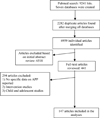Prevalence and correlates of antipsychotic polypharmacy: a systematic review and meta-regression of global and regional trends from the 1970s to 2009
- PMID: 22534420
- PMCID: PMC3382997
- DOI: 10.1016/j.schres.2012.03.018
Prevalence and correlates of antipsychotic polypharmacy: a systematic review and meta-regression of global and regional trends from the 1970s to 2009
Abstract
Objective: To assess the prevalence and correlates of antipsychotic polypharmacy (APP) across decades and regions.
Methods: Electronic PubMed/Google Scholar search for studies reporting on APP, published from 1970 to 05/2009. Median rates and interquartile ranges (IQR) were calculated and compared using non-parametric tests. Demographic and clinical variables were tested as correlates of APP in bivariate and meta-regression analyses.
Results: Across 147 studies (1,418,163 participants, 82.9% diagnosed with schizophrenia [IQR=42-100%]), the median APP rate was 19.6% (IQR=12.9-35.0%). Most common combinations included first-generation antipsychotics (FGAs)+second-generation antipsychotics (SGAs) (42.4%, IQR=0.0-71.4%) followed by FGAs+FGAs (19.6%, IQR=0.0-100%) and SGAs+SGAs (1.8%, IQR=0.0-28%). APP rates were not different between decades (1970-1979:28.8%, IQR=7.5-44%; 1980-1989:17.6%, IQR=10.8-38.2; 1990-1999:22.0%, IQR=11-40; 2000-2009:19.2% IQR=14.4-29.9, p=0.78), but between regions, being higher in Asia and Europe than North America, and in Asia than Oceania (p<0.001). APP increased numerically by 34% in North America from the 1980s 12.7%) to 2000s (17.0%) (p=0.94) and decreased significantly by 65% from 1980 (55.5%) to 2000 (19.2%) in Asia (p=0.03), with non-significant changes in Europe. APP was associated with inpatient status (p<0.001), use of FGAs (p<0.0001) and anticholinergics (<0.001), schizophrenia (p=0.01), less antidepressant use (p=0.02), greater LAIs use (p=0.04), shorter follow-up (p=0.001) and cross-sectional vs. longitudinal study design (p=0.03). In a meta-regression, inpatient status (p<0.0001), FGA use (0.046), and schizophrenia diagnosis (p=0.004) independently predicted APP (N=66, R(2)=0.44, p<0.0001).
Conclusions: APP is common with different rates and time trends by region over the last four decades. APP is associated with greater anticholinergic requirement, shorter observation time, greater illness severity and lower antidepressant use.
Copyright © 2012 Elsevier B.V. All rights reserved.
Conflict of interest statement
Dr.Gallego, Dr. Zhang and Dr. Bonetti have nothing to disclose.
Figures


References
-
- Advokat C, Dixon D, Schneider J, Comaty JE., Jr Comparison of risperidone and olanzapine as used under "real-world" conditions in a state psychiatric hospital. Prog Neuropsychopharmacol Biol Psychiatry. 2004;28(3):487–495. - PubMed
-
- Ahn J, McCombs JS, Jung C, Croudace TJ, McDonnell D, Ascher-Svanum H, Edgell ET, Shi L. Classifying patients by antipsychotic adherence patterns using latent class analysis: characteristics of nonadherent groups in the California Medicaid (Medi-Cal) program. Value Health. 2008;11(1):48–56. - PubMed
-
- Ambuhl B, Wurmle O, Michel K. Prescribing practice of psychotropic drugs in a psychiatric university clinic. Psychiatr Prax. 1993;20(2):70–73. - PubMed
-
- Ananth J, Parameswaran S, Gunatilake S. Antipsychotic polypharmacy. Curr Pharm Des. 2004;10(18):2231–2238. - PubMed
-
- Andersen SE, Johansson M, Manniche C. The prescribing pattern of a new antipsychotic: a descriptive study of aripiprazole for psychiatric in-patients. Basic Clin Pharmacol Toxicol. 2008;103(1):75–81. - PubMed
Publication types
MeSH terms
Substances
Grants and funding
LinkOut - more resources
Full Text Sources
Medical
Molecular Biology Databases
Miscellaneous

